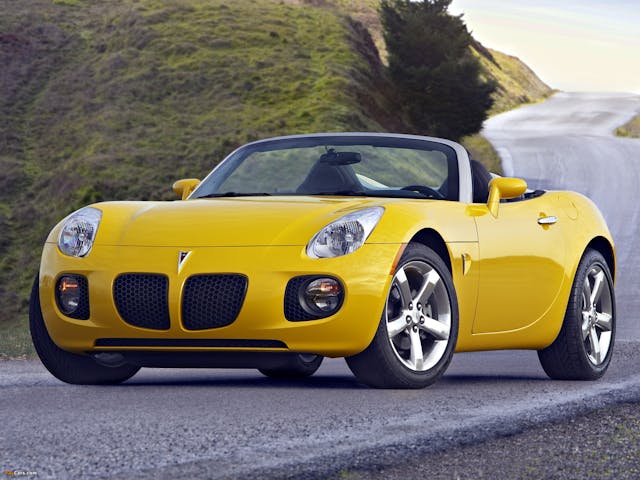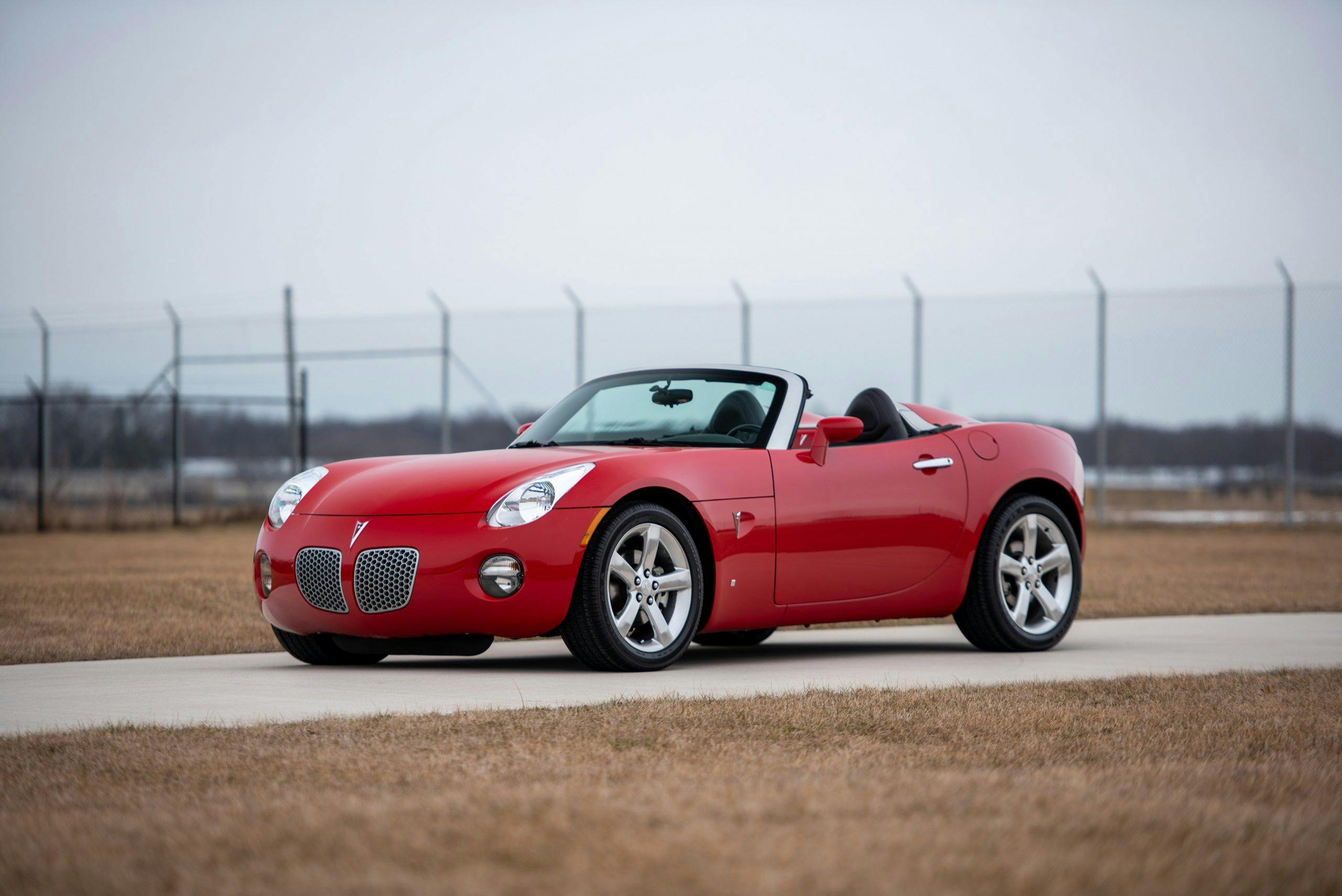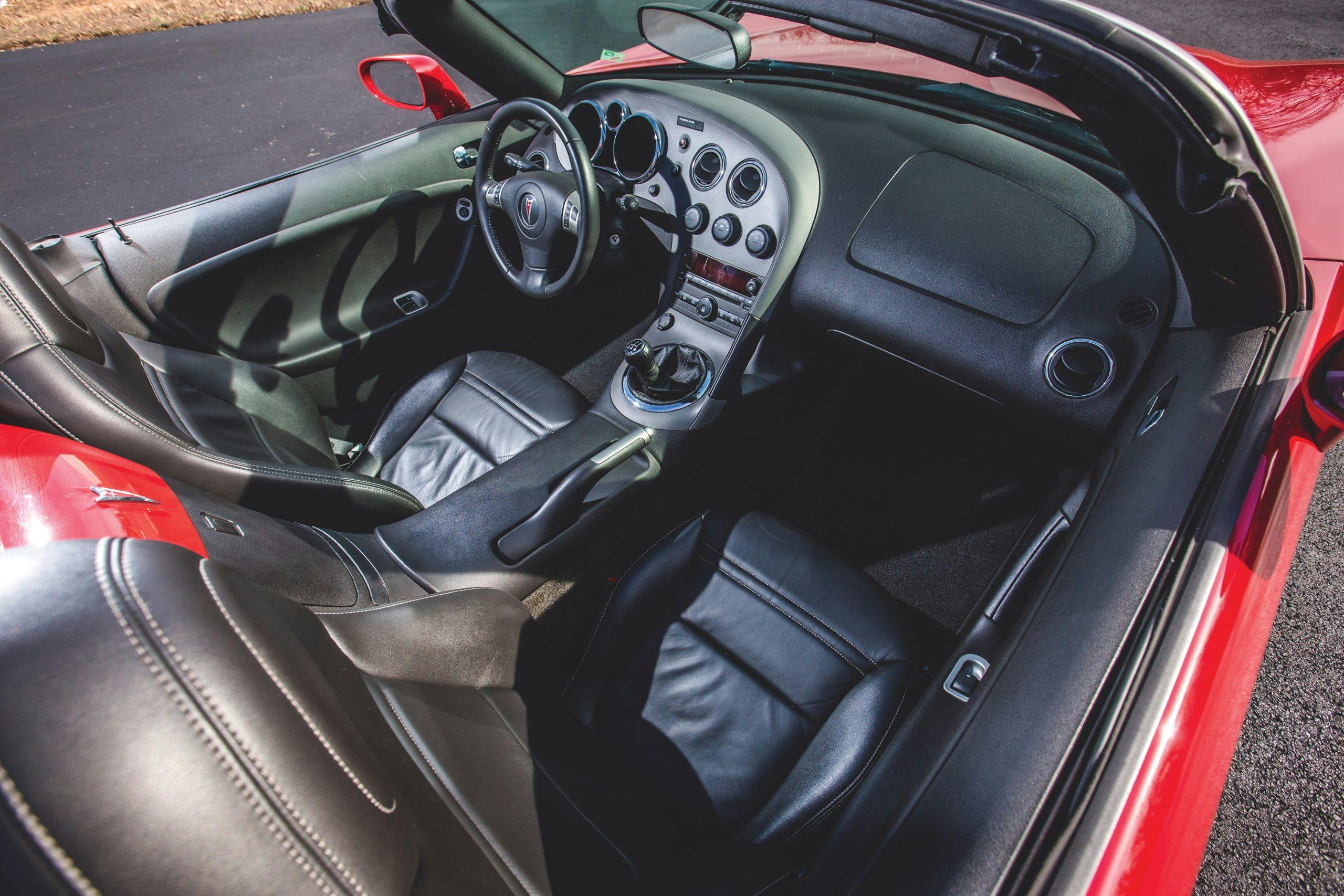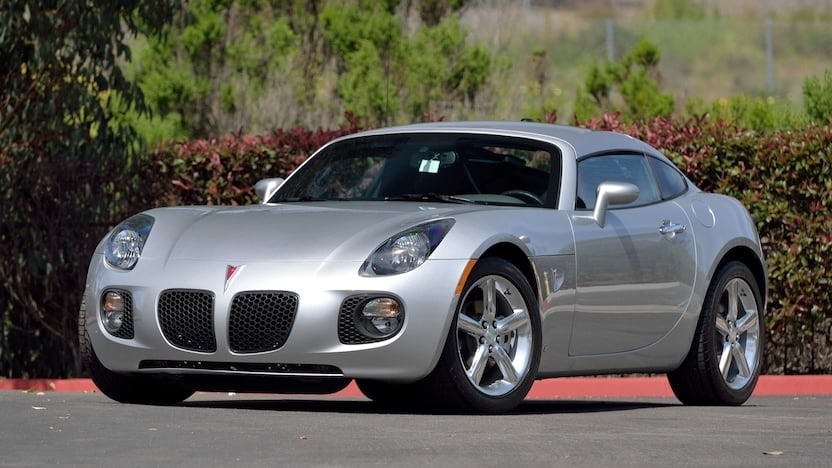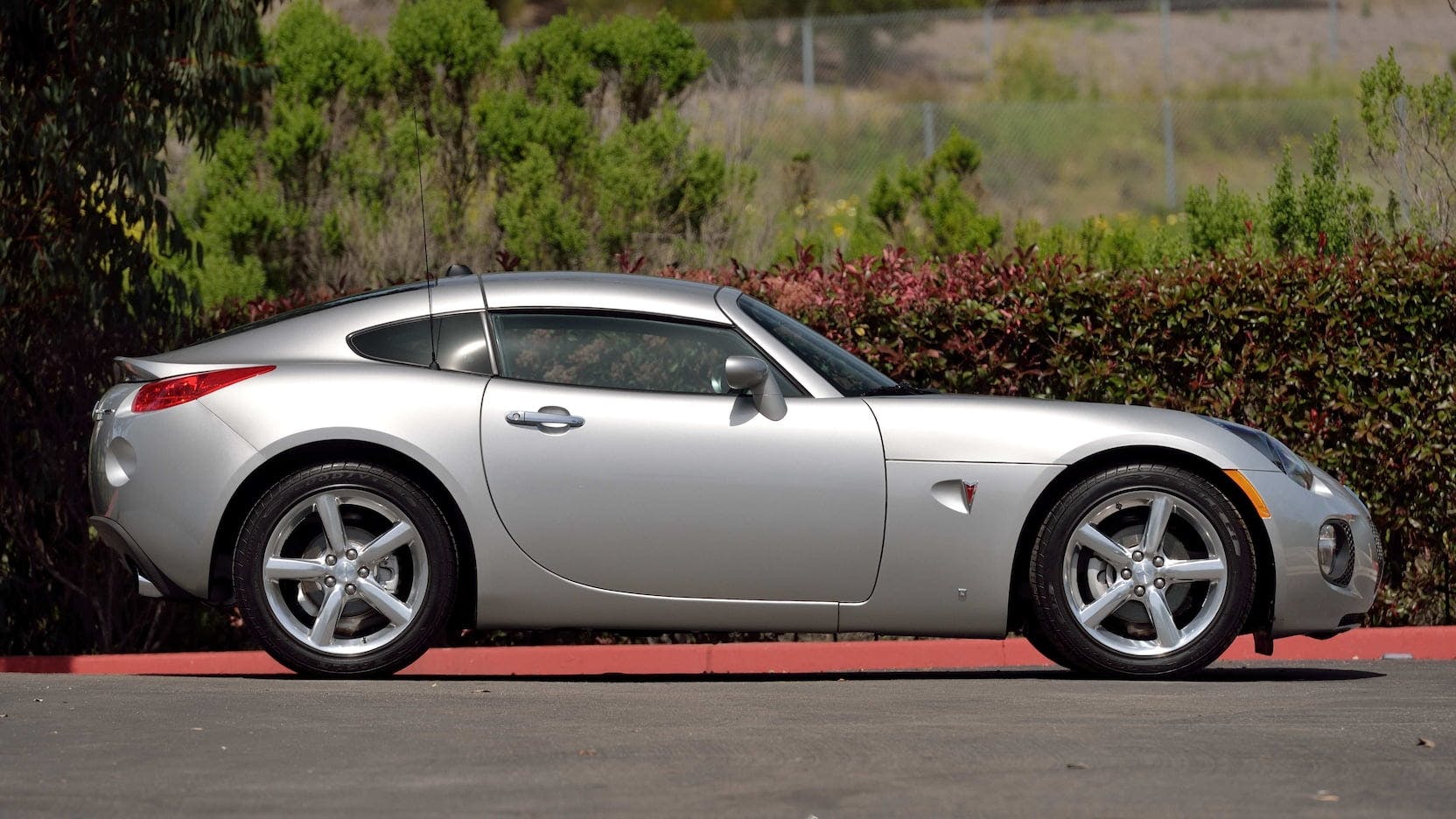The 2006–10 Pontiac Solstice offers an affordable alternative to Japanese roadsters
The list of American sports cars that aren’t Corvettes is, unfortunately, a short one. There’s plenty of blame to go around, but let’s point the finger at GM for a moment. It’s common knowledge that the higher-ups have always been uneasy about building two-seaters, scared of buyers straying from Chevrolet’s precious Corvette. Of all the kids in the GM family, Pontiac suffered the most from this sports car favoritism, despite being the General’s “performance division.” Pontiac’s Banshee concept got quashed in the ’60s. Its Fiero was compromised and underfunded in the ’80s. But, in 2006, Pontiac finally got another go in the two-seater game in the form of a Miata-fighting four-cylinder drop-top called the Solstice.
Today, 10 years after it became one of the many casualties of GM’s Great Recession bankruptcy, the Pontiac Solstice offers an affordable alternative to the established small roadsters from Japan. And although it’ll never be a Blue Chip collector car, the best examples are no longer getting cheaper. Some of the ultra-rare performance models are already seriously collectible and surprisingly expensive.
The Solstice first appeared as a concept car, in both roadster and coupe forms, at the 2002 North American International Auto Show in Detroit, although a production version (roadster only) wasn’t ready until the fall of 2005. GM’s entry into the small sports car market rode on an all-new design, code-named the Kappa platform, and it wasn’t just limited to Pontiac. In an attempt to jazz up the almost completely jazz-less Saturn lineup, GM built a reskinned version called the Saturn Sky. Over in Europe, the Sky was rebadged as the Opel GT, and in Korea it became the Daewoo G2X. The Solstice kept its own unique styling. You can argue about the looks, and many people have, but it’s best described as “distinctive.”

Under the skin, the Kappa platform’s architecture “looks a lot like a naked ’Vette that just got out of a cold pool,” Car and Driver wrote, pointing a finger at the car’s hydroformed frame rails. Aside from the steering wheel, the Solstice shares little with the ’Vette, but the rest of the Solstice is a case study in parts bin engineering. The HVAC system is out of the Hummer H3, the door handles are from the Chevy Cobalt, the reversing lights are from the GMC Envoy, and the rear axle and differential are from the Cadillac CTS. The 2.4-liter Ecotec four is the mill found in boring GM front-drivers from the Pontiac G6 to the Chevy HHR, and the five-speed manual is the same one you got in a Chevy Colorado pickup truck, albeit with altered linkage and shorter throw.
The benefit of all that corporate recycling was a temptingly low price, and the Solstice hit showrooms starting at 20 grand, which was Pontiac’s original target and put the car squarely in Miata territory. With 177 horsepower and 166 pound-feet of torque, the Pontiac had the Mazda beat on grunt, but at 2888 pounds the Solstice is on the beefy side. An NC (2005–15) Miata, itself the husky kid in the family, tips the scales at less than 2500. Period reviewers lamented the lack of tail-swinging oversteer that makes rear-drive roadsters fun, while other gripes included a lack of storage space and the fact that you have to get out of the car to operate the soft top. Overall, though, the comments were positive.
Motor Trend complained about the “cheapoplasticity” of the interior (this is 2000s GM we’re talking about, after all), but said it “fits like a glove” and called the steering “light, quick, communicative, and fully up to the best moves the stiff chassis has to offer.” Road & Track’s skidpad and slalom times put the Solstice in the same ballpark as the Nissan 350Z and BMW Z4. Car and Driver noted “a willingness to please that will keep you grinning,” and concluded “it’s not perfect, but it’s a pure, satisfying roadster for 20 grand.”
Pontiac sold more than 21,000 Solstices for 2006 (more than the Miata that year), and on track the car won SCCA Showroom Stock B and Touring 2 championships. Off to a good start, then, but things got even better in 2007 with a hotter Solstice GXP model. A new 2.0-liter engine with direct injection and a dual-scroll turbocharger offered 260 hp and 260 lb-ft of torque, a limited-slip diff and antilock brakes were standard, and Pontiac added a new ratio between second and third gears. On the outside, a black honeycomb grille and small chin spoiler at the front, and dual exhausts at the back distinguish it from the standard car. Some reviewers noted a bit of turbo lag, but the 0–60 time dropped from about 7 seconds to less than 6 in the GXP, and with a base price of just $26,000 the Solstice GXP was an even better performance value. It was a movie star, too, with some brief appearances in Michael Bay’s flashy 143-minute 2007 General Motors commercial also known as Transformers.
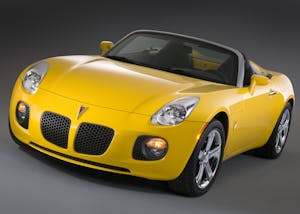
In early 2009, Pontiac added a coupe to the Solstice lineup, in both base and GXP forms. The removable 31-pound targa roof panel kept the appeal of open-air motoring alive, but only on 100 percent sunny days, since the panel is too big to actually fit anywhere inside the car. Another addition for 2009 was a “Street Edition” of 500 cars finished in Brazen Orange with black stripe, and with special wheels and contrast stitching on the interior.
Neither of these cars could save the Solstice, however, as GM had declared bankruptcy and Pontiac was on the chopping block. The Wilmington, Delaware, factory that built the Kappa platform cars closed in July 2009 after just 20 Solstices with 2010 VINs were completed. In all, Pontiac built nearly 66,000 Solstices. About 13,000 of them were GXP convertibles, and only about 1200 Solstice coupes were completed—781 of them GXPs.
The Solstice may have only lasted from 2006 to 2010, but these days there are some key differences to consider when it comes to price. Higher-mileage used cars are still depreciating, and most cars out there still command well under their condition #2 (Excellent) values, but we noticed an uptick for the nicest examples and performance models, so we added the Pontiac Solstice to the Hagerty Price Guide last year.
At the bottom of the ladder are the base Solstice convertibles, which are also the most common. They currently carry a value of just $7700 in #3 (Good) condition and $14,000 in #2 (Excellent) condition. A delivery-mile, best-in-the-world example in #1 (Concours) condition barely cracks 20 grand. For any Solstice convertible, the available hardtop is a big bonus. Expect to pay an extra $1500 for one.
The base model Solstice Coupe, only available for 2009–10, carries a condition #3 value of $13,500 and a #2 value of $18,000. Because the 2010 models are extremely rare and hardly ever come to market, expect one of those to command a significant premium. That goes for any 2010 Solstice.
As for the turbocharged GXPs, the GXP convertible ranges from $11,900 in #3 condition to $17,800 in #2 condition and $27,000 in #1 condition. Meanwhile, the GXP Coupe is the one everybody wants, as it’s in a different ballpark in terms of rarity and value. A condition #2 example is worth $37,100. Subtract 15 percent for cars with an automatic transmission. Again, 2010 cars are worth significantly more than ’09s.
Looking at the Saturn Sky as the most direct comparison, the Sky Redline is worth a little more than the equivalent Solstice GXP convertible, but the base Saturn Sky commands a little less than the base Solstice convertible. So, if you can tolerate telling people you drive a Saturn, that’s one way to save a few bucks.
At auction, the most expensive Solstice we’ve seen is a 2010 five-speed GXP Coupe Heritage Edition (one of two built) that sold for $55,000 back in 2011. More recently, a 7700-mile 2009 GXP Coupe sold for $38,500 in 2019. Other expensive Solstices we’ve seen weren’t even factory cars, they were Mallet V8 conversions done by Mallett Performance Cars, a tuner outside Charlotte that will also sell you a supercharger kit for your Ecotec-powered car. One Mallett V8 conversion brought $36,000 on Bring a Trailer last year.
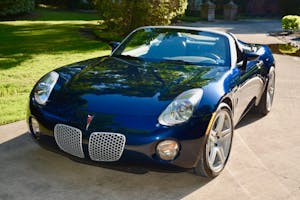
The Solstice is an unusual sports car, and so is its fan base. Being a modern, sporty, and affordable car, you’d think that it would be most popular with the kids. Not so. In fact, it’s the opposite. Baby Boomers, who make up 32 percent of the collector car market, account for 62 percent of the buyer interest for the Solstice. Pre-Boomers, who make up just 7 percent of the market, make up 11 percent of the interest for the Solstice. It’s a similar generational breakdown for the Saturn Sky, although the Saturn is slightly more popular than the Pontiac among the youngest enthusiasts. Their loyalties clearly lie with Japanese roadsters like the NB Miata and AP2 (2004–09) Honda S2000, for which a whopping 42 percent of buyer interest comes from Millennials.
What all this means for the Solstice in the longer term isn’t clear. The easy thing would be to compare it to Pontiac’s other two-seater, the Fiero, which after all these years is still cheap and underappreciated, but there are some key differences. First, super-rare Solstices like the GXP Coupe have already gotten somewhat collectible. The Solstice also wasn’t nearly as compromised a design as the Fiero, didn’t suffer from a massive PR fail early in its run, and is a significantly rarer car. We’ll just have to wait and see what happens to the Solstice in another 20 years, but for now it’s a (mostly) affordable roadster with a home-grown character that stands out from the imports.
